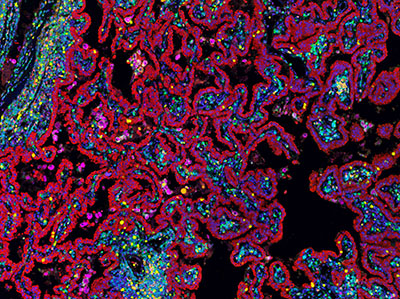The SIG Beat
NEWS FROM AND ABOUT THE SCIENTIFIC INTEREST GROUPS
NEW SIG: Multiplex Immunofluorescence Scientific Interest Group

CREDIT: HOUSSEIN A. SATER, NCI
A multiplex spectrally unmixed immunofluorescence image of a lung-cancer tissue stained with seven biomarkers.
Intramural and extramural scientists who are using multiplex immunohistochemistry and immunofluorescence technologies to study complex tissue structures (such as tumor microenvironments) can share their knowledge via the Multiplex Immunofluorescence (MxIF) SIG. These technologies are used to identify the presence of multiple biological markers in a single tissue sample or different samples. The methodology can be an invaluable tool for tumor-tissue immune-profiling and as a way to identify multiple treatment targets in the same tissue section. This approach requires critical thinking and bioinformatic tools for effective segmentation, algorithm building, and advanced spatial analysis. This SIG aims to disseminate information about these technologies and foster new research collaborations across the NIH campus and around the world. The MxIF SIG welcomes pathologists, clinicians, postdocs, computer scientists, bioinformaticians, and others who have an interest in or are helping to move this field forward. The group meets monthly to discuss topics that include, but are not limited to, technical difficulties with staining, optimization, and validation. The MxIF SIG will host a seminar series featuring NIH and outside experts in the field (times will be determined later). The long-term premise of this new community is to generate innovative approaches in the field of digital pathology through artificial-intelligence tools. For more information about the MxIF SIG and instructions for how to join the LISTSERV mailing list, go to https://oir.nih.gov/sigs/multiplex-immunofluorescence-scientific-interest-group-mxif-sig or you can contact the group chair and advisor: Houssein A. Sater (houssein.abdulsater@nih.gov).
NEW SIG: Epilepsy Scientific Interest Group
The Epilepsy Scientific Interest Group (SIG) brings together investigators, clinicians, and researchers who are interested in epilepsy and in understanding its pathophysiology and the effects of treatment on neural function and connectivity. Epilepsy studies at NIH take place in several institutes including the National Institute of Neurological Disorders and Stroke, the National Institute of Mental Health, and the Eunice Kennedy Shriver National Institute of Child Health and Human Development. NIH intramural researchers are using structural and functional imaging before and after surgical resection; investigating how surgical resection on regions of the human cortex affect neural plasticity and cognitive function; exploring intraoperative and long-term recordings of neural activity that are routinely acquired in the course of treatment; and evaluating human brain tissue samples to understand the physiology and molecular and genetic pathways in both normal and diseased brains. The Epilepsy SIG provides a forum for facilitating interactions among clinicians and researchers, and for sharing progress in ongoing studies and investigations across institutes and centers. The SIG holds meetings approximately every two months; each meeting provides an opportunity for investigators and clinicians inside or outside NIH to present their work. For more information about the Epilepsy SIG and how to join the LISTERV mailing list, go to https://oir.nih.gov/sigs/epilepsy-scientific-interest-group or contact one of the chairs: Kareem Zaghloul (kareem.zaghoul@nih.gov) or Sara Inati (sara.inati@nih.gov).
For a complete list of Scientific Interest Groups, go to https://oir.nih.gov/sigs/view-name.
This page was last updated on Monday, April 4, 2022
